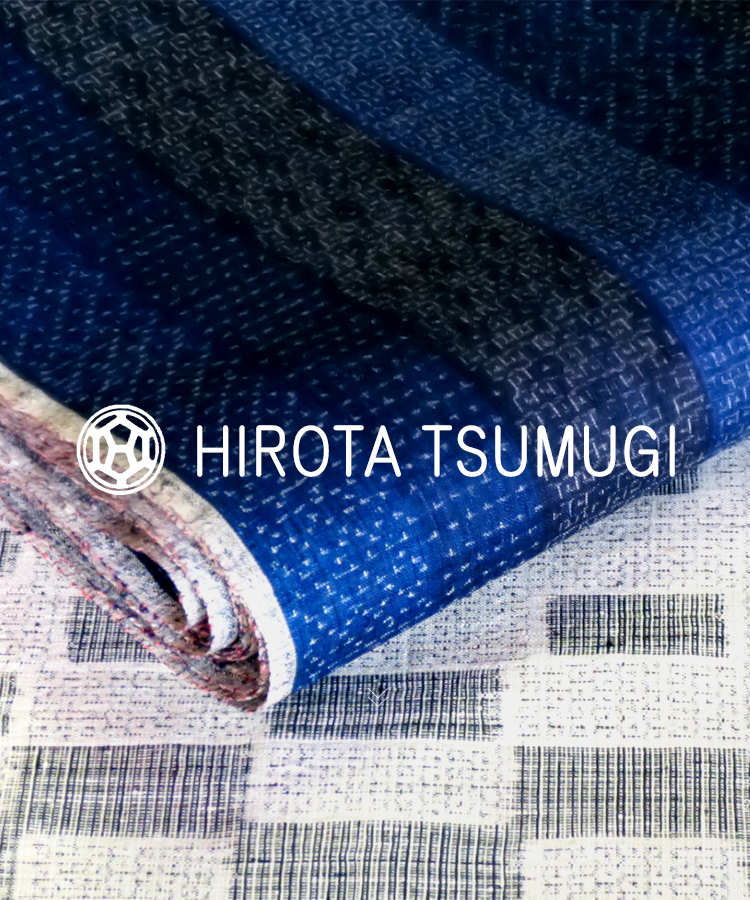
What is Tsumugi?
Supreme slub-woven Kimono fabrics
uniquely developed across Japan
From ancient times, sericulture and silk weaving were self-sufficient household-based handicrafts for agricultural off seasons across Japan.
"紬 Tsumugi" yarns are made from irregular-shaped rubbish cocoons, called “屑繭 Kuzumayu”, which are dissolved into silk floss and spun into tsumugi yarns, dyed using organic dyes made from local plants and then handloomed into the famous tsumugi fabric.
Compared to the glitter of ordinary silk fabric, tsumugi has a softer luster.
Naturally slubbed tsumugi yarns are durable, but at the same time, have an extremely soft silk floss texture. Historically, tsumugi was worn by farmers, samurai and merchants at all social scales, and is symbolic of the history of the kimono, Japanese textile and culture itself.
Although Japanese people are wearing kimono less and less these days, kimono enthusiasts still wear kimonos made from tsumugi for luxurious, but chic daily-wear.
Tsumugi fabrics, as they are produced by traditional techniques, require an experienced craftsman and an enormous amount of time – weaving a bolt (38cm×1,280cm) sometimes takes over a year!
Nowadays it is a hugely concerning that all local weaving regions are facing the risk of losing their traditions because of the difficulty of finding and training successors for these craftsmen.
Still, today, we can be thankful that we can take these supreme hand made textile artworks in our hands, and think of the traditions, climates and craftsmanship that have gone into them…

Who we are
Holding the consistent stance as the Tsumugi specialty
In 1946, just after WWⅡ, Hirota Tsumugi was founded as a kimono fabric wholesaler in Kyoto, and has constantly produced superior quality tsumugi kimono fabrics for over 80 years, based in Kyoto.
As a kimono fabric wholesaler/supplier, we work together with a large number of the remote local weaving regions and artisans, and wholesale the fabrics to kimono retail stores across Japan.
During this time we have played our part in creating and preserving tsumugi kimono fashion and culture in Japan.
However, the situation is changing -- Japanese people are wearing kimono less and less, and tsumugi traditions are at risk of dying out.
Some of the weaving traditions have already disappeared. In the next 10 or 20 years, even the major traditions might vanish, because of the aging of the artisans without trained successors.
In recent years, we have started to export fabrics outside of Japan for various uses, including fashion, furniture and interior design materials primarily to the US and Europe.
So, now we feel that we need to help connect tsumugi and its traditions to the future of fabric and design in the world.
We believe in the beauty of tsumugi, not only for use in kimono, but also for other, yet unknown, ways to enhance the world.


Our Products
The largest collection of Japanese Tsumugi textiles,
hearing custom design order as well
We stock over 2,000 different textiles and kimono bolts annually from over 50 different weavers and artisans across Japan.
We deal with Tsumugi silk, raw silk, silk crepe, ramie, cotton, and Shizen-fu including Shifu, Basho, Huji, Kudzu or Shina.
We focus on natural materials and handmade traditions of Japan.
Our manufacturing partners and exclusively contracted textile artisans are scattered across Japan, from the sun-drenched islands of Okinawa to the heavy snowfall area of Nigata.
A bolt of Kimono fabric is called “Tanmono”, an around 40cm wide×1280cm long fabric unit, which is the minimum necesary amount of fabric for tailoring into a kimono. All fabrics from stock and ship worldwide.
Some weavers are capable of weaving the wider width and longer fabric. So, we can hear your request of custom order including design and size. Feel free to contact us and we are happy to discuss with you about your ideal fabrics.
Products

The word “紬, Tsumugi” consists of “糸 yarn” and “由 draw out”, implying the primitive act of spinning a yarn by fingers directly pinching off from natural materials, such as cocoon’s floss silk or plants’ bast-fibers.
Before the modern time, it was fully self-sufficient in making their own clothes, through spinning, dyeing and weaving, by incorporating their surrounding natural privileges.
Not only in Japan, it used to be a common human practice. But today, textile products and clothing cultures have been rapidly standardizing across globe.
Traditional ethnic cultures and techniques are all tactic knowledge, handed down from person to person over generations, which will be almost impossible to restore if once disappeared.
Tsumugi was fortunate enough to survive until today thanks to the Japanese kimono garment culture in which Japanese people believe in the value and beauty of textile craftsmanship, and be thankful to the diversity of the traditions in this nation.